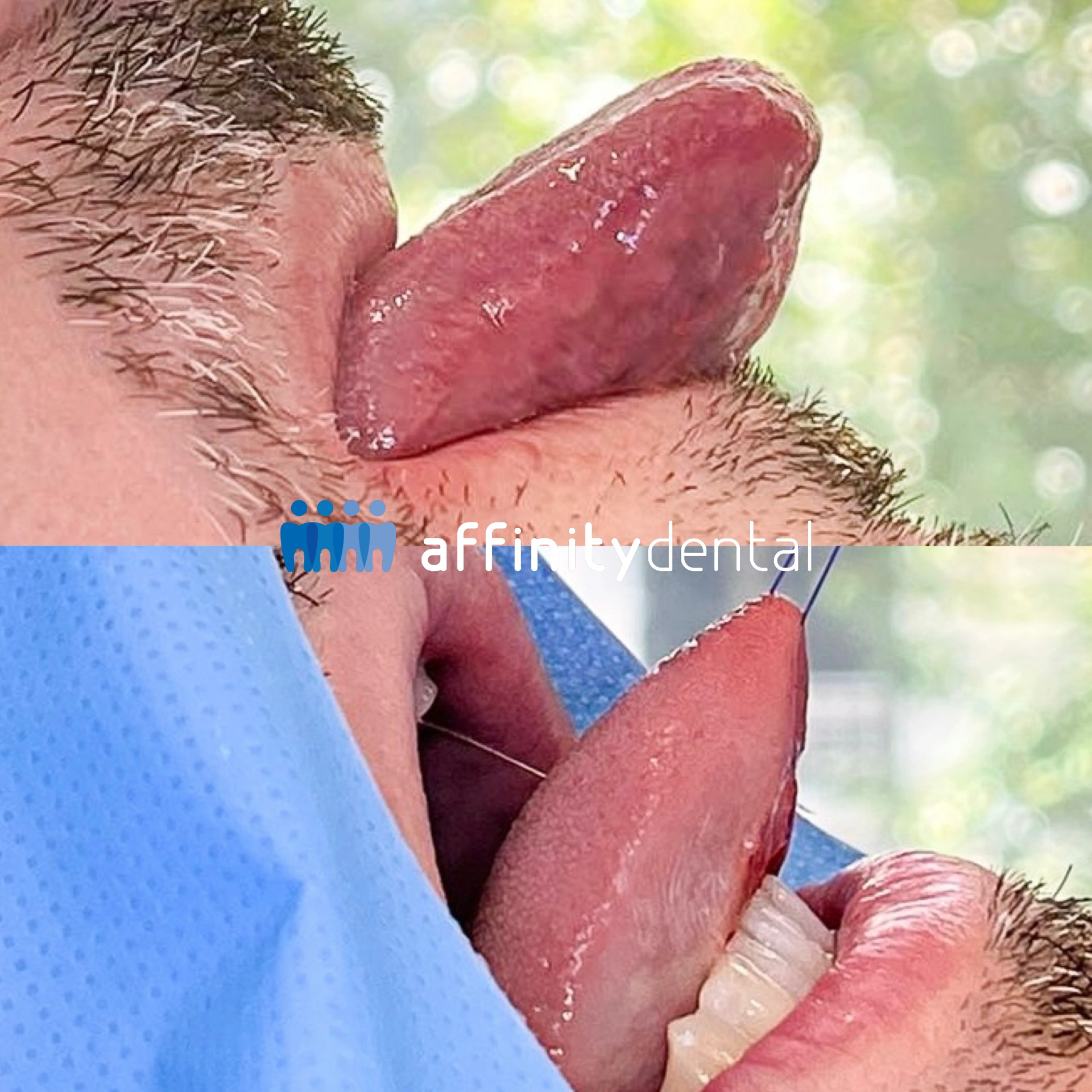
Tongue-tie Surgery
Improve Speech, Comfort, and Function with Expert Oral Surgery
Many people live with speech difficulties, discomfort while eating or speaking, and even social anxiety—all caused by a condition that can be corrected with a simple surgical procedure. Known as a tongue tie, this issue can interfere with daily life and overall oral function, particularly when left untreated into adolescence or adulthood. Fortunately, modern Tongue Tie Surgery offers a safe and effective solution.
At Affinity Dental Clinics, we perform Tongue Tie Surgery as part of our specialized Oral Surgery services. Our team of formally trained Oral Surgeons have successfully treated numerous patients with tongue tie issues, restoring proper tongue mobility and improving quality of life.
Whether you’re an adult struggling with speech, discomfort, or poor oral function—or a teen who has been referred by an orthodontist or speech therapist—Affinity Dental Clinics offers the experience, technology, and care to help you get lasting results through expert Tongue Tie Surgery.
What Is a Tongue Tie?
A tongue tie, medically referred to as ankyloglossia, is a condition in which the lingual frenum—the band of tissue connecting the underside of the tongue to the floor of the mouth—is unusually short, thick, or tight. This restricts the tongue’s range of motion and may interfere with normal activities such as:
• Swallowing properly
• Eating comfortably
• Maintaining oral hygiene
• Playing wind instruments or sports that require oral dexterity
• Resting the tongue in a natural position
Tongue tie can affect people at any age, but when left untreated in childhood, it can continue to cause issues into adolescence and adulthood.
Symptoms of Tongue Tie in Teens and Adults
Unlike infants, where the most obvious sign of a tongue tie may be feeding difficulty, older patients often experience a different set of challenges. Some signs that you may benefit from Tongue Tie Surgery include:
• A lisp or slurred speech
• Inability to stick the tongue out past the lips
• A notched or heart-shaped tongue tip when attempting to extend the tongue
• Discomfort or tightness in the tongue while talking or eating
• Jaw or neck tension due to compensation for limited tongue movement
• Chronic bad breath due to limited tongue range affecting oral hygiene
• Challenges with orthodontic treatment, relapse, or poor tongue posture
At Affinity Dental Clinics, we assess tongue tie cases in teens and adults based on function, speech, oral health, and the patient’s goals.
What Is Tongue Tie Surgery?
Tongue Tie Surgery, also known as a lingual frenectomy, is a minor oral surgical procedure that removes or releases the restrictive frenum beneath the tongue. The goal is to allow the tongue greater mobility, flexibility, and function.
Unlike laser or infant frenectomies, which are sometimes done in pediatric settings, our procedures at Affinity Dental Clinics are performed using traditional surgical techniques under local anesthesia or Conscious Sedation, depending on patient needs and complexity.
Why Choose Affinity Dental Clinics for Tongue Tie Surgery?
At Affinity Dental Clinics, Oral Surgery is a dedicated specialty. Our formally trained Oral Surgeons have extensive experience in soft tissue surgeries such as lingual frenectomies. Each procedure is performed with attention to anatomy, aesthetics, and long-term function.
Each of our clinics is fully equipped with modern tools and technology to ensure optimal results, including:
- Digital X-rays for safe and accurate imaging
- Cone Beam CT Scans (CBCT) when needed to assess related anatomical structures
- Surgical-grade instruments for precise tissue removal
- Sterile, hospital-grade operating rooms
- Advanced infection control protocols for maximum patient safety
Whether you’re having your procedure at our clinic in Makati, BGC, Alabang, Ortigas, Parañaque, or Cebu, you’ll receive the same standard of world-class care.
If you’re anxious about oral surgery or undergoing multiple procedures, we offer Conscious Sedation, administered by a board-certified Anesthesiologist. This conscious sedation option keeps you relaxed, pain-free, and comfortable throughout the surgery, without the deeper risks of general anesthesia.
Who Should Consider Tongue Tie Surgery?
You may be a candidate for Tongue Tie Surgery if:
• You’re undergoing orthodontic treatment and have poor tongue posture
• You experience jaw, neck, or facial muscle tension due to compensation
• You’re in voice training, public speaking, or performing arts and need unrestricted oral movement
• You want to improve overall oral health and hygiene by increasing tongue range
• You’ve been referred by a dentist, orthodontist, speech therapist, or ENT specialist
Our oral surgeons will evaluate your case during a comprehensive consultation and recommend the most appropriate course of action.
The Tongue Tie Surgery Process: Step-by-Step
Here’s a step-by-step overview of how Tongue Tie Surgery (Lingual Frenectomy) is performed:
Your treatment begins with a thorough evaluation by one of our Oral Surgeons. This includes:
- Full medical and dental history
- Examination of the lingual frenum
- Assessment of speech, mobility, and tongue posture
- Intraoral photographs and, if necessary, CBCT imaging
We’ll also discuss your goals and explain what to expect before, during, and after the procedure.
If you’re a good candidate for Tongue Tie Surgery, we’ll create a customized treatment plan that includes:
- Choice of anesthesia or Conscious Sedation
- Specific surgical technique based on your anatomy
- Recovery timeline and follow-up visits
- Recommendations for post-operative tongue exercises or referrals for myofunctional therapy, if needed
Tongue Tie Surgery is typically performed in less than 30 to 45 minutes. The process includes:
- Local anesthesia is used to numb the area
- If Conscious Sedation is selected, you’ll be monitored by an anesthesiologist
- The tight frenum is carefully incised or removed using precise surgical tools
- Sutures may be placed to aid in proper healing
- You’ll rest in recovery briefly and receive aftercare instructions before being discharged
We do not use lasers. Our approach is surgical, controlled, and clinically grounded for the best outcomes in mature patients.
Aftercare and Recovery
Recovery from Tongue Tie Surgery is generally straightforward. Most patients experience only mild soreness or swelling in the first few days.
Common Aftercare Instructions:
• Apply cold compresses to reduce swelling (first 24 hours)
• Eat soft foods for 2–3 days post-procedure
• Avoid spicy, acidic, or crunchy foods
• Rinse gently with saltwater or antiseptic mouthwash
• Avoid touching the surgical area with fingers or tongue
• Follow through with tongue mobility exercises as recommended
Most patients return to work or school the next day, with full healing typically occurring within 1 to 2 weeks.
Functional and Aesthetic Benefits of Tongue Tie Surgery
Tongue Tie Surgery can deliver profound improvements in both comfort and function. Benefits include:
Removing the restriction often leads to enhanced articulation, especially for sounds requiring elevation or tip movement of the tongue.
Patients often report a feeling of freedom and relaxation in the mouth, neck, and jaw after surgery.
Chewing and swallowing become more efficient and comfortable.
Improved tongue mobility helps with natural cleaning action, reducing the risk of bad breath, plaque buildup, and oral infections.
Many patients feel more confident speaking in public, performing, or smiling widely after treatment.
Tongue-Tie Surgery – Frequently Asked Questions
What is tongue-tie?
Tongue-tie, or ankyloglossia, is a condition where the tissue (lingual frenum) under the tongue is too short, tight, or thick, restricting tongue movement. This can cause difficulty with speech, eating, and maintaining oral hygiene.
What is tongue-tie surgery?
Tongue-tie surgery, also called a lingual frenectomy, is a minor oral surgery that involves releasing or removing the restrictive frenum beneath the tongue to improve mobility and function.
Does Affinity Dental Clinics offer tongue-tie surgery for infants?
No. At this time, Affinity Dental Clinics does not perform tongue-tie surgery for infants or babies. We may consult but typically refer them to hospital-based specialists. We focus on treating older children, teenagers, and adults.
Who are suitable candidates for tongue-tie surgery at Affinity?
We treat:
• Children with tongue-tie affecting speech or eating
• Teenagers/adults with restricted tongue movement or discomfort
• Patients with functional concerns impacting oral health
How is the procedure done?
The procedure is typically performed under local anesthesia, sometimes with Conscious Sedation for anxious patients. The restrictive frenum is surgically released using sterile instruments or a soft tissue laser, depending on the case.
Is the procedure painful?
No, the surgery is done under anesthesia. Mild soreness may follow, but recovery is quick and usually managed with simple care or OTC medication.
How long does tongue-tie surgery take?
Typically 15 to 30 minutes, depending on the complexity and use of sedation.
What is the recovery time?
Most patients recover in a few days. Stretching exercises may be advised to prevent reattachment and encourage mobility.
Can this procedure help with speech issues?
Yes, especially if restricted tongue movement is the cause. Speech therapy may still be recommended for best results.
Is tongue-tie surgery common in adults?
Yes. Adults with longstanding tongue-tie often see improvement in comfort, speech, and oral hygiene.
Are there risks or complications?
Risks are rare but may include bleeding, mild swelling, or scar tissue. These are minimized when performed by trained oral surgeons at Affinity Dental Clinics.
How do I schedule a tongue-tie evaluation at Affinity Dental Clinics?
Simply call or message any of our branches in Makati, BGC, Alabang, Ortigas, Parañaque, or Cebu to schedule a consultation with our oral surgeons.

Book Your Tongue Tie Surgery Consultation Today
If you’re struggling with speech, discomfort, or functional limitations due to tongue tie, there’s a solution. At Affinity Dental Clinics, we combine surgical precision, modern technology, and compassionate care to deliver safe, effective Tongue Tie Surgery tailored to your unique needs.
Call us today or 📩 book your consultation online at any of our branches in Makati, BGC, Alabang, Ortigas, Parañaque, or Cebu. Our Oral Surgery team is here to help you speak, eat, and live more comfortably—with confidence and freedom.
Let us help you preserve what matters most—your health, your smile, and your future.
Book an Appointment
One moment, your message is being sent...
Please wait for the confirmation message before going back or closing your browser.
Sub heading
Content Place Here without Image

Content Continuation
Sub heading

Content Place Here without Image
Content Continuation
Sub heading

Content Description
Sub heading

Content Description Numbered
Intro Paragraph
Additional (Optional)
- Items
- Items
- Items
- Items
Component for Direct Content without image
Intro Paragraph
2nd Pragraph Optional
Closing paragraph
Component for Steps Content without image
Intro Paragraph
Text Description
- This list is optional, if the content does not have bulleted items remove the "ul and /ul"
- Items
- Items
Outro Paragraph (Optional)
Component for Steps Content with image

Intro Paragraph
Text Description
- This list is optional, if the content does not have bulleted items remove the "ul and /ul"
- Items
- Items
Outro Paragraph (Optional)
Other design for itemized content
Intro (copy this if there are more paragraphs)
Text Description
Table Title No Image
| Column Heading | Column Heading | Column Heading | Column Heading | Column Heading |
|---|---|---|---|---|
| Row Data | Row Data | Row Data | Row Data | Row Data |
Table Title with Image

| Column Heading | Column Heading | Column Heading | Column Heading | Column Heading |
|---|---|---|---|---|
| Row Data | Row Data | Row Data | Row Data | Row Data |
Frequently Asked Questions
Answer
Answer
Answer






